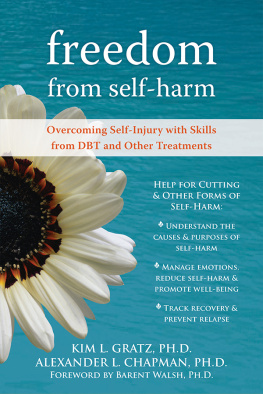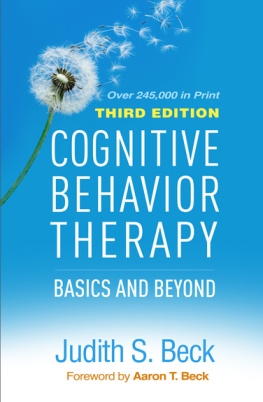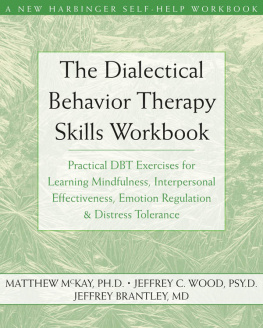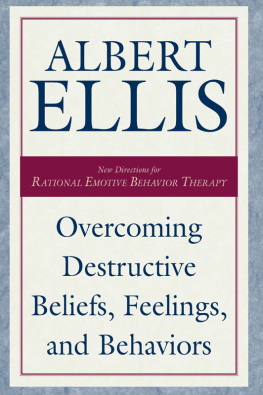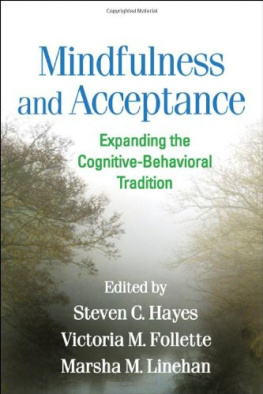Writing this book comes at the end of a long succession of events. Over the years, many people have made contributions to what finally became this book. The scientific background is documented in the list of . We want to take the opportunity here to thank a long line of teachers, colleagues, and students who for many years, or for shorter periods, have been in dialogue with us concerning the question of what psychotherapy is and how it is best conducted. Special thanks to Sandra Bates, Ata Ghaderi, and Gardar Viborg for their thoughtful comments on the early draft of the Swedish manuscript. Thanks to Steve Hayes for taking the book abroad; Liza Ask and Sandra Bates for contributing to the translation process; and Jean M. Blomquist for her editing of the text. To everyone at Context Press and New Harbinger Publications, thank you for all your work in bringing this book into being. Last but not least, we want to thank our clients, former and present, who together with us have struggled with the question of how to understand what we do and how to change the things we want to change.
Afterword
Behavior is what the organism is doing.
B. F. Skinner, 1938
What happens after reading this book? For verbal organisms such as we humans are, a book can control our behavior in situations far from the situation where it is read. So writing a book is about changing behavior. Our hope, of course, is that for you who have just read this book as a part of (or in preparation for) your work with clients, the book will function as an antecedent (A) for useful therapeutic work (B). We hope that you have found itand will continue to find ituseful in several ways: useful for understanding what is happening on the therapeutic playing field; useful in broadening your own behavioral repertoire when you are doing psychotherapy; and useful in being of assistance to people like Jenny, Mirza, Anna, Peter, Marie, Alice, and Leonard. We hope this usefulness, for example, means that someone like Jenny stops cutting herself, is discharged from the psychiatric ward, and involves herself in relationships that are meaningful to her; that someone like Mirza wholeheartedly creates a new life in his new country and reestablishes healthy contacts with his old country, both in his mind and in reality; and that someone like Alice learns to live a life out of what she wants rather than in response to her fears. To our thinking at least, these are objectives that clients like these might have. Surely the reader, in a similar fashion, can imagine change that would be valuable for the other people we have followed throughout this book. To facilitate such change is one of the desirable consequences that motivated us to write this book.
Desirable consequences, however, are not necessarily the same as actual consequences. As we draw this writing project to a close, were experiencing the satisfaction of accomplishment as an actual consequence. What other actual consequences will follow as you and others read this book, we do not know. We only know what has been stated before: the one who lives will get to C.
Jonas Ramner, Ph.D., has worked as a licensed psychologist since 1989. He earned his license as a psychotherapist in 1995. He is currently assistant professor in the Department of Psychology at Stockholm University in Stockholm, Sweden. He has extensive clinical experience, mainly in the treatment of anxiety and mood disorders, an experience that stems both from general psychiatry and private practice. Since 1998 he has served as a clinical supervisor, both for students and trained psychologists, and as a regular lecturer in clinical psychology at the university. Ramner earned his Ph.D in 2005 with the thesis Behavioral Treatments of Panic Disorder with Agoraphobia: Treatment Process and Determinants of Change.
Niklas Trneke, MD, is a psychiatrist and has worked as a senior psychiatrist in the department of general psychiatry in his hometown Kalmar (in the southeast of Sweden) from 1991 until he started private practice 1998. He earned license as a psychotherapist in 1996 and was originally trained as a cognitive therapist. Since 1998 he has worked mainly with acceptance and commitment therapy, both in his own practice and as a teacher and clinical supervisor. His clinical experience ranges from psychiatric disorders such as schizophrenia to common anxiety and mood disorders with high prevalence in the general population.
Part 1
Describing Behavior
Chapter 1. Topographical Aspects of Behavior
The task of clinical behavior analysis is to formulate the problem in a way that increases the possibility for change. The individuals who seek our help usually show up with their own idea or conceptualization of the problem, for example:
- Marie wants help to overcome her lack of self-confidence.
- The staff finds Jenny troublesome because she is so self-destructive and manipulative.
- Peter and Anna want counseling for their hopeless marriage.
- Leonard is referred to a therapist for treatment of his persistent depression.
Formulating the Problem
All of the statements above contain a problem-formulationthe kinds of formulations we use in everyday language. Professional language is often quite similar to this, even if different words are used. Lets start by looking at Marie. What is she describing when she uses the expression lack of self-confidence?
I guess Ive never been one of those who love speaking in front of a group. But it has gotten so much worse in the last few years. Now I can hardly sit down and have a cup of coffee with a colleague. Its even hard to go out if I know that Im about to see someone. The worst part about it is that I never know what theyre thinking. They must think that Im kind of strange or something like that.
Marie describes a number of behaviors:
- She avoids situations where she has to speak in public.
- She avoids having a cup of coffee with colleagues.
- She thinks twice about going out if she is going to meet people.
- She worries over what other people might think about her.
- She thinks that others might find her strange.
To Maries description, we could also add observations made by the therapist: while talking, Marie rarely makes eye contact and she tends to sit slightly turned away from the therapist. We now have started to formulate her problems in terms of observable behavior. It should be noted that most of these observations are not made by the therapist. They are made by Marie herself. The therapist has never seen her avoid speaking in public or having a cup of coffee. Neither has she seen Marie hesitating to go out. But we could assume that if the therapist were present in these everyday situations, these behaviors would be observable by the therapist. Marie, on the other hand, has made direct observations. It is her behavior. To call something observable behavior means that someone can actually observe the behavior in question. In a therapeutic context, this someone will most often be the client. This underlines the notion of therapy as a collaborative task, where the therapist largely depends on clients observations of their own behavior.
However, it is not the case that Marie comes to therapy with a list of observable behaviors that she considers the problem. Her definition of the problem is that she lacks self-confidence. When asked about her withdrawn and avoidant lifestyle, she explains, It surely must be that I lack self-confidence somewhere deep inside. To her, the lack of self-confidence becomes a cause of her behavior.
Lets consider how we might detect this problem with self-confidence. How could we observe it? We can observe Maries avoidance, her hesitance, her behavior in social situations. The more we observe, the more behaviors we will detect. But we will never actually see any self-confidence.



